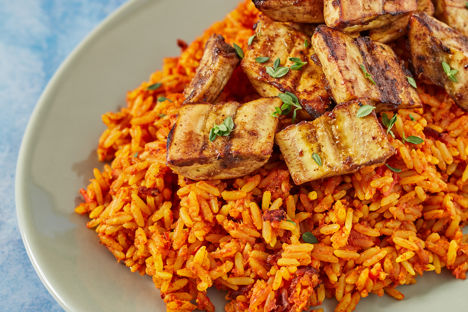
An introduction to West African cooking
West African food may not be as popular as Indian or Chinese in the UK, but it's finally getting the national recognition it deserves. We take a look at the flavours that make West African cuisine tick, as well as a few must-try dishes.
An introduction to West African cooking
West African food may not be as popular as Indian or Chinese in the UK, but it's finally getting the national recognition it deserves. We take a look at the flavours that make West African cuisine tick, as well as a few must-try dishes.
Though West African cuisine may remain somewhat of an enigma to many of us, historically speaking it is one of the world’s most influential food cultures. The first human settlements in West Africa date back to 4000 BCE, and the roots of West African food certainly reach this far too; many of the indigenous vegetables and spices that define West African food – rice, yam, plantain, cassava and the like – all existed there thousands of years ago.
By the colonial period, West African peoples were trading regularly with Europe and the Mediterranean, exporting cotton and precious metals in return for all the wonders of the New World. European explorers introduced tomatoes, chillies and peanuts to West Africa, and in turn, they took rice, black-eyed peas, okra and other ingredients back with them. Today, the influence of West Africa on food around the world is unmistakable. Rice, black-eyed peas and okra are staples in West Indian cuisine. In Louisiana and the American Deep South, Creole classics like gumbo, yams, greens and red rice are directly inherited from West African dishes – a result of the slave trade which brought millions of West Africans over to America.
No single ingredient displays the deep-seated importance of West African cuisine like the kola nut, which originated in West Africa and arrived in America via West African slaves, who used them to make stale water drinkable on the long voyage across the Atlantic. The kola nut went on to become a key ingredient in – you guessed it – Coca-Cola, which itself became synonymous with American food and drink culture. Lots of what we think of as American, West Indian and even European food actually originates from West Africa.
To refer to West African food as a singular entity is, of course, a little misleading. We’re more aware of the intricacies of regional cuisines than we have ever been and West Africa is no different – even within a single country there are often several different ethnic groups with their own specific dishes and cuisines. In fact, territorial boundaries don’t have a great impact on eating habits in West Africa; this is possibly a result of colonialism, where European settlers defined their own borders without any regard for pre-existing territories, thus bisecting various different tribes. That said, there are some distinct, unique flavours and ingredients that characterise West African cuisine as a whole and are popular across the length and breadth of the region. Let’s take a look!
Flavours and ingredients
The first thing that strikes many people when they eat West African food is the heat! Chillies arrived in Africa by way of European explorers and quickly became an important part of the diet – people found that chillies actually helped them to keep cool by encouraging them to sweat. Although the origins were practical, that distinctive fruity scotch bonnet flavour has become a fundamental part of West African cookery.
There are too many seasonings and spices in West African cuisine to name them all, but there are a few that are especially notable and unique. Grains of paradise (also known as melagueta pepper) are the seeds of the Guinea pepper, and are prevalent all over West Africa, with a peppery flavour that has hints of cardamom and coriander about it. Grains of Selim (also known as uda pods), meanwhile, are seed pods from a rainforest tree – they’re often crushed and put into stews to give a deep, musky flavour, or in Senegal they’re smoked and used to flavour a popular Senegalese coffee called café Touba.
Also common is the use of bouillon – both in liquid and cube form – but West African cooks make their own bouillon equivalent called sumbala. Traditionally it is made from néré seeds (also known as locust beans) – the seeds are boiled to remove the casing, then cleaned and fermented, giving the resulting paste a pungent, umami-rich flavour. The process has a great deal in common with miso-making in Japan; in fact, the use of soybeans is becoming more common in West Africa as néré seeds are less common and harder to process.
Rice has been cultivated in West Africa for at least 3,000 years, making it one of West African cuisine’s oldest and most important staples. It is a cornerstone of the region’s most famous dish – jollof rice – as well as other important dishes like Senegalese thieboudienne, Ghanaian waakye, and an omnipresent side to go along with other meat, fish and vegetable dishes.
Once upon a time, the West African diet would have been almost completely made up of vegetables; that isn’t the case now of course, but vegetables still play a big part in every meal. Tubers and root vegetables are always present at the West African table, particularly sweet potato, yam, plantain and cassava (also known as manioc or yucca). The latter three are often pounded down to make fufu – a starchy, dough-like mound which is eaten with soups and sauces. You just take a ball with your fingers, make an indent in it and scoop so the indent fills with soup, then eat!
Hundreds of varieties of leafy greens are also eaten, including the leaves of pumpkin, cassava, baobab and sweet potato. And then of course there’s the famous black-eyed pea, eaten in rice dishes and delicious akara fritters.
Meat and fish were not traditionally a large part of the West African diet – originally it would have been very vegetable-centric – but these days they play a much larger role. With much of West Africa having access to the Atlantic Ocean, seafood is incredibly common along its coast. It is often eaten fresh – as in this Jamestown prawn recipe from Zoe Adjonyoh – but it’s also dried and smoked, becoming a pungent fishy condiment which adds flavour to soups and stews.
Chicken is the most common meat you’ll come across in West Africa – it’s eaten pretty much everywhere. So far as red meat goes, goat is the most common but beef, pork and mutton are eaten more frequently as you get further inland. Barbecued meat skewers are especially common; in Nigeria they eat suya – skewers of beef, coated in a spicy peanut condiment and grilled.
Popular dishes
Jollof rice is a one-pot rice dish that is eaten all over West Africa. No discussion on West African food would be complete without jollof rice, but again, this is a prime example of how you cannot paint an entire region with the same culinary brush. There is no exact recipe for jollof rice – different people from different tribes and countries prepare the dish in different ways, and debate rages on between Nigerians and Ghanaians over which nation makes the best jollof and can claim it as their own.
This grilled meat dish has its roots in Nigeria, where street vendors barbecue rows of skewers in the street. Traditionally suya is made with beef, which is skewered and coated in a spicy condiment (also called suya) which is made up of garlic, ginger, ground uda pods, ground peanuts and chilli powder. The result is typical of West African food – rich, spicy and moreish. Lerato Umah-Shaylor makes her delicious version using chicken thigh instead, and serves on a bed of aromatic coconut rice.
Yassa is another dish that originates in Senegal, but has become popular all over West Africa. It’s typically made with white fish or chicken, but it’s not so much the contents that makes a good yassa as the sauce – a delicate balance of sweated onions, lemon and grains of paradise, with a dash of smoked paprika for depth and a bit of heat from chopped scotch bonnet. Lerato’s recipe is a great start for anyone interested in cooking some West African food of their own.
These delicious black bean fritters are common all over West Africa, albeit under different guises. In Ghana they’re known as akara or koose, but you may also see them called kose, accara or kosai in other West African countries. The black beans are crushed then mixed with the other fritter ingredients (okra, cayenne pepper, scotch bonnet and onion) before being lightly aerated and deep-fried to make a delicious crispy snack.



